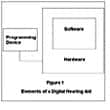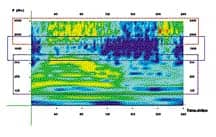| While most dispensing professionals will not routinely use the Fifield Technique due to time constraints, it remains a handy and effective (and largely unknown) procedure for producing an earmold that reduces feedback in cases where other impressions fail. This article revisits the steps in producing a multilayer impression, provides guidance on its fabrication and discusses its practical applications. |
Leakage of sound around the otoplastic (earmold or earshell) provides unintentional, uncontrolled and variable venting in many hearing instrument fittings. This often leads to acoustic feedback. When leakage occurs, a portion of the output signal from the hearing instrument receiver radiates back to the microphone. When the portion of the output being fed back at a particular frequency equals the gain of the hearing instrument at that frequency (and is in phase with the input), audible oscillation, or feedback, occurs. Reducing the gain of the hearing instrument could eliminate the oscillation. However, inadequate sound amplification would result from this course of action.1 To prevent acoustic feedback and feedback-related sound distortion, the otoplastic needs to seal effectively with the ear canal.
In practice, the effectiveness of otoplastic seal is controlled through the thickness of in-lab impression coating, commonly made of wax.2 The canal portion of the ear impression is enlarged by either dipping in melted wax, or by applying melted wax with a brush or a spatula and then smoothing the build-up over with an electric wax knife. Unfortunately, this process is carried out without checking the build-up in the client’s ear to make sure that the seal is adequate and the fit is comfortable. Since each ear is different, errors in applying either too much or too little build-up, or applying it in the wrong place, have been occurring. With high-powered hearing instruments, even a slight error in the fit can result in a hearing instrument that will feedback, necessitating a remake using different waxing conditions.
Multilayer Impression-Taking
Fifield3 wondered whether there was a better method of improving the acoustic seal in hearing instruments than through waxing. He focused on impression-taking techniques and, after an extensive study, proposed an improved method of impression taking which he called the “multilayer technique.” The features of this new technique included:
1. The impression was produced in three stages;
2. The controlled build-up of canal area on the impression was carried out in the ear. This ensured that the impression conformed to the structures of the ear and the problems of discomfort associated with impression waxing were avoided;
3. The impression was built up more than once, if necessary. In this way, the impression was enlarged gradually so that the minimum build-up necessary to achieve a seal was applied;
4. The technique incorporated a test to prove that the impression was sealing the canal effectively;
5. The multilayer impression did not require any further build-up or modification by the earmold or hearing instrument manufacturer.
The following is a brief description of the three stages of the technique and also a method of testing the seal.
Step 1: The Primary Impression
An oto-block of appropriate size attached to a strong thread is selected. The block is tied to the end of a vinyl or silicone rubber tube that is about 5 cm (2") long and has an internal diameter of approximately 2 mm (0.076"), as shown in Fig. 1a. The thread from the oto-block is then pushed down through the tubing. This tubing is used at a later stage to test the seal of the impression and is not in any way related to the tubing of the finished earmold.

|
Figs. 1a-b. The multilayer impression-taking technique requires two types of oto-blocks. The first block (1a) is for the primary impression, and consists of a foam block, thread and a length of vinyl or silicone tubing. The other oto-block (1b) is used in Step 3, and is made of cotton. |
The oto-block is inserted in the ear, not deeper than the second anatomical bend of the canal. A high viscosity (heavy-bodied) silicone impression material is then mixed and syringed into the ear. When set, the finished primary impression should show the detail of the ear canal and concha, and should have the end of the tubing showing at the tip of the canal. The tubing should remain imbedded in the impression (Fig. 2a).

|
Figs. 2a-c. The multilayer impression: First, a primary impression (2a) is taken with a high-viscosity (heavy-bodied) impression material. Next, the primary impression is built up in the patient’s ear with a medium-viscosity (medium-bodied) silicone (2b). |
| This procedure of building up the impression may have to be repeated a number of times until a satisfactory seal is achieved. When the built-up impression demonstrates an effective air-tight seal, a "wash" coating of a low viscosity (soft) silicone is applied to obtain a smooth impression surface (2c). | |
Step 2: Canal Build-Up
A thin coating of a medium-viscosity (medium-bodied) silicone is applied to the surface of the primary impression, on the area between the canal tip and the canal entrance. The impression is then returned to the ear before the material has begun to set. Gentle pressure is applied for a short time to the outside of the impression in the region of the canal to assist the material to “flow.” After the material has set, the impression is removed again and inspected. The build-up will have spread outside the canal entrance and the coating inside the canal will have adjusted itself to conform to the varied compressibility of the ear tissue (Fig. 2b).
þ Testing the Seal: When the impression is fitted back in the ear, an air pump and manometer (part of an acoustic impedance meter or tympanometer) are attached to the tubing protruding from the impression. The pressure is increased to a maximum of +200 daPa and maintained at that level for 5 seconds. The patient is encouraged to open and close his/her jaw to ensure that leakage does not occur during these movements. If the pressure decreases during the test, the impression requires a build-up with another layer of the soft silicone. The dispensing professional may have to repeat this build-up procedure several times, testing after each attempt, until a satisfactory seal is achieved. This part of the impression-taking procedure is considered complete only when an effective airtight seal is provided.
Carrying out the procedure of the impression being first removed from and then returned to the ear for the pressure seal test is important because it breaks the seal between the impression and the ear. If not administered, most impression materials will stick to the ear tissue firmly enough to demonstrate an effective airtight seal.
Step 3: Applying a "Wash"
The final stage of making the impression is designed to record the fine detail of the ear structure on the impression. The canal-portion of the impression may be extended during this stage, if required. The otoblock is cut off and the tip of the impression trimmed, if necessary.
A new oto-block (Fig. 1b) tied to a thread is selected and inserted into the canal to give the desired length to the finished impression. A low viscosity (thin-bodied) silicone material is syringed into the ear canal and over the surface of the concha. The impression is then gently reseated in the ear before the material begins to set. During this process, the thin silicone is displaced from under the impression and flows up, around the sides and outward. After this silicone sets, the impression is gently removed from the ear and the impression will now have a light coating of the low viscosity material over its surface, as shown in Fig. 2c. Where the impression has been built-up and is sealing against the canal wall, the material previously used for the build-up will show through the final (outer) coating.
The canal of the impression should then be trimmed to the desired length, if necessary. Instructions to the earmold lab should indicate that the impression should not be built up before being manufactured.
For guidelines on selecting high, medium or low viscosity impression materials, the reader is referred to a previous article by the author.5
Study Results
Following the development of this technique, Fifield conducted a study on 45 children (74 ears).3 The children had long-standing problems with feedback from earmolds that were made by using conventional techniques. All but two molds made from multilayer impressions enabled the hearing instruments to be used at the required amplification level without feedback. For the two exceptions, it was found that feedback resulted from sound radiation through the walls of the earmold tubing. After employing a thicker-walled tubing, it was found that the gain could be increased to the required levels.
Macrae1, in a series of experiments conducted on a varying number of young adults, compared the effectiveness of static pressure seal in earmolds made from non-waxed multilayer impressions and from waxed standard impressions. The static pressure seal was tested as proposed by Fifield.3 For the waxed impressions, the effectiveness of earmold seal ranged from 15-65%, depending on the thickness of the impression coating. Earmolds made from non-waxed multilayer impressions provided an airtight seal 88% of the time. Even though the targeted score of 100% was not achieved, earmolds made from multilayer impressions still demonstrated superb sealing properties.
Discussion
The multilayer impression-taking technique has not gained any significant popularity over the years. Several factors apparently contribute to the method’s lack of popularity and explain why it did not become widely used even in Fifield’s native Australia:
• It takes about an hour to obtain a multilayer impression as opposed to approximately 10-20 minutes for other techniques.
• Acoustic feedback does not occur in most hearing instruments manufactured by labs with reliable otoplastic work.4
• In humans possessing narrow or crooked ear canals, the returning of the multilayer impression to the ear canal can be most challenging, particularly if the oto-block for the primary impression was inserted past the second anatomical bend of the canal.
More importantly, there are additional methods that effectively address feedback. Unintentional sound leakage in hearing instruments usually has two different causes.5 The first is the softness of the ear tissue; the second, which is at least as common, is the increase in ear canal diameter caused by the patient’s downward movement of his/her jaw. If separate causes exist, it appears more practical to approach each cause individually. The ear tissue compressibility is best tested through the employment of a standard-viscosity or high-viscosity impression material. The magnitude of the ear canal widening is best illustrated on the impression by utilizing the open-jaw impression-taking technique.6 Because it is unpredictable which of these two factors will be more critical for a given patient, it is most appropriate to combine these two methods. The advantage of taking an open-jaw impression with a standard-viscosity impression material lies in the procurement of a high-quality ear imprint without increasing the time of impression making.
Despite the reasons for its limited popularity, Fifield’s method has at least one element that appears very interesting: the static pressure-seal test used for evaluating the accuracy of the earmold seal and the risk of feedback. However, in interpreting such tests results, two factors should be considered. The first is that, if the earmold loose fit is equal to or greater than an equivalent of a 0.5 mm vent, the air pressure in the ear canal will be close to zero.7 Secondly, sound leakage around the earmold will not necessarily lead to acoustic feedback.
An acoustically tight earmold is not the same as an airtight earmold.8 An air-tight earmold means a lower limiting frequency of zero. An acoustically tight earmold means a lower limiting frequency of about 50-100 Hz. Acoustic feedback in hearing aids develops well above 100 Hz, typically between 1700 and 2500 Hz.9 In other words, an airtight seal is not necessarily imperative for high-power hearing instrument fittings.
Summary
The multilayer impression-taking technique should be considered an alternative in situations when other impression-taking methods fail in providing adequate acoustic seal in earmolds and hearing instruments. Even though the method is time consuming, otoplastics made from multilayer impressions can be expected to provide the necessary acoustic seal more frequently than otoplastics made from impressions built up with wax by the earmold lab technician. Although used infrequently, the Fifield Technique can be an excellent tool to keep in the dispensing professional’s “bag of tricks.”

References
1. Macrae J: Static pressure seal of earmolds. J of Rehab Res and Dev 1990; 27 (4): 397-410.
2. Pirzanski C: Why are my ear impression being waxed? Hearing Review 2000;7 (3): 56-58
3. Fifield D: A new ear impression technique to prevent acoustic feedback with high-powered hearing aids. Volta Review 1980; 82 (1): 33-39.
4. Pirzanski C. & Maye V: Variances in the remake rate of earmolds made of hard and soft materials. Internal study. Mississauga, Ontario: Starkey Labs Canada, 1999.
5. Pirzanski C: Critical factors in taking an anatomically accurate impression. Hear Jour 1997; 50 (10): 41-48
6. Pirzanski C: An alternative impression-taking technique: The open-jaw impression. Hear Jour 1996; 49 (11):30-35.
7. Pirzanski C: unpublished data.
8. Johansen A: Magnitude of the acoustic feedback as a function of leakage in earmolds. Scand Audiol 1975, Suppl 5: 271-279.
9. Vonlanthen A: Hearing instrument technology, 1995: 278-279.
Correspondence can be addressed to HR or Chester Pirzanski, Starkey Laboratories-Canada Ltd., 7310 Rapistan Ct., Mississauga, Ont. L5N 6L8; email: [email protected].




.gif)